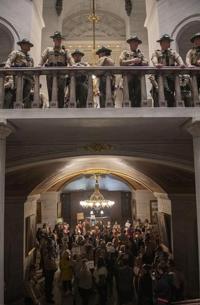For many Latinos filling out forms that ask for racial and ethnic identification can be daunting and confusing, especially when there is not a box that reflects their identity.
This often leaves many Latinos checking Hispanic boxes that do not encompass who they are and creating data that does not reflect their lived experiences, according to a new report released Wednesday by researchers at the University of California, Los Angeles.
Analysis by the UCLA Latino Policy and Politics Institute showed that the methods used by the U.S. Census and Office of Management and Budget to collect racial and ethnic data does not reflect the lived experiences of Latinos, especially Afro-Latinos. The report also provides some suggestions on how to generally improve collection of racial and ethnic data.
“The current methods of data collection used by the OMB fail to accurately reflect the realities of racial discrimination faced by Latinos,” said Cecilia Nuñez, co-author of the report titled “ ”
“These oversights have significant implications for policy development and resource allocation," said Nuñez, a graduate student and policy fellow at the institute. "Accurate and actionable data is essential for crafting effective policies and interventions that address the systemic inequities impacting Latinos and bringing meaningful change.”
Maritza Guridy, a resident of Philadelphia, said her whole life she has had to deal with never having one box that encapsulates who she is. Instead she checks her ethnicity as Hispanic and her race as Black.
In 2020, Guridy was a census worker in Philadelphia helping minorities fill out the federal survey, explaining what doing so meant for their community. She found many just like her struggled to check a box that reflected how they self-identified.
“If a person considers themselves Afro-Latino there wasn’t a section for them,” Guridy said. “It is something that does need to be changed. It does need to be recognized and respected, if that is a person’s choice on how to identify themselves.”
Nuñez said when data ignores the diversity of the Latino community and the “vastly different experiences across unique identities” the issues they face get left out of policy conversations.
Earlier this year, the U.S. government changed the way it by race and ethnicity, in an effort that federal officials said would more accurately count residents who identify as Hispanic, Middle Eastern and of North African heritage. Under the revisions, . That will give respondents the option to pick multiple categories at the same time, such as “Black,” “American Indian” and “Hispanic.”
Research has shown that large numbers of Hispanic people aren’t sure when that question is asked separately because they understand race and ethnicity to be similar and they often pick “some other race” or do not answer the question.
Nancy Lopéz, a professor and the director and co-founder of the University of New Mexico’s Institute for the Study of “Race” and Social Justice, said with the change people who check the Hispanic and Black or African American boxes are going to be marked as multi-racial instead someone who is of Latino ethnicity and a certain race. Lopéz said this is problematic as data will then show a higher number of people who are multiracial and undercut the number of Afro-Latinos.
“I call that statistical gaslighting,” Lopéz said. “Because they say we’re keeping the analytical distinction, we’re not calling Hispanic a race but we’re going to ask about it with race.”
Filling out the 2020 Census was one of the Methuen, Massachusetts resident Antonio Caban’s most troubling memories, having to check the other box despite being a Brazilian who identifies as Latino. Caban likened filling out the census to trying to find a Hispanic name on a keychain at souvenir stores.
“This has been an issues for a lot of people in the Latino community, particularly Afro-Latinos and Asian-Latinos,” Caban said.
For Syreeta Bond, a resident of Austin, Texas, filling out forms can be difficult to navigate when there is no consensus among agencies what options to offer for Latinos. As an Afro-Latina, she found it weird that she could not check a box that reflected her dual identity.
“I love my Black side and I love my Puerto Rican side, but I always had to pick one or the other,” Bond said. “If it has Hispanic or Latino I will pick that one because if it says Black but not Latino, I can’t pick that one.”
In their report, the UCLA researchers propose adding a street or perceived race question to the census and for the census office to define its demographic parameters clearly. The report identified “street race” as the race a stranger would assume someone to be based on their physical appearance.
Nuñez said including the question would help to solve the implications of combining the race and ethnicity question, and provide additional understanding into how Latinos are racialized in public.
“It highlights the ways in which racism and discrimination is often based on being a visual person of color regardless of how one identifies and the ways that might matter, especially for Latinos,” Nuñez said.
___
The Associated Press receives financial support from the Sony Global Social Justice Fund to expand certain coverage areas. AP is solely responsible for all content. Find AP’s for working with philanthropies, a list of supporters and funded coverage areas at .








































